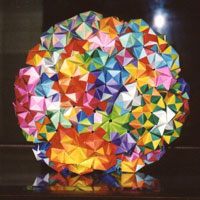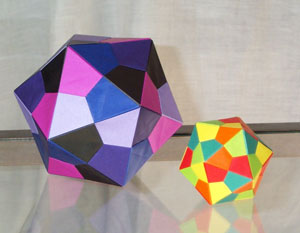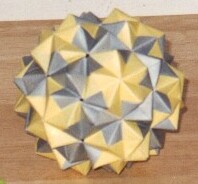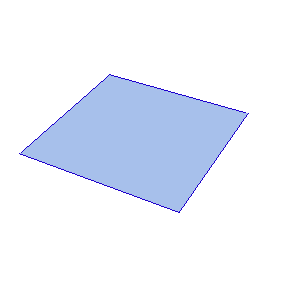另請參閱
平面摺紙,
摺疊,
幾何作圖,
地圖摺疊,
郵票摺疊,
斯托馬琴拼圖,
七巧板
使用 探索
參考文獻
Alperin, R. C. "A Mathematical Theory of Origami Constructions and Numbers." New York J. Math. 6, 119-133, 2000.Andersen, E. M. "paperfolding.com." http://www.paperfolding.com/.Andersen, E. M. "Origami and Math." http://www.paperfolding.com/math/.Biddle, S. and Biddle, M. The New Origami. New York: St. Martin's Press, 1993.Brill, D. Brilliant Origami: A Collection of Original Designs. Tokyo: Japan Pub., 1996.Cerceda, A. and Palacios, V. Fascinating Origami: 101 Models by Adolfo Cerceda. New York: Dover, 1997.Demaine, E. D.; Demaine, M. L.; and Lubiw, A. "Folding and Cutting Paper." In Proc. Japan Conf. Discrete Comput. Geom. New York: Springer-Verlag, 1998.Demaine, E. D.; Demaine, M. L.; and Lubiw, A. "Folding and One Straight Cut Suffice." In Proc. 10th Ann. ACM-SIAM Sympos. Discrete Alg. (SODA'99). Baltimore, MD, pp. 891-892, Jan. 1999.Demaine, E. D.; Demaine, M. L.; and Mitchell, J. S. B. "Folding Flat Silhouettes and Wrapping Polyhedral Packages: New Results in Computation Origami." In Proc. 15th Ann. ACM Sympos. Comput. Geom. Miami Beach, FL, pp. 105-114, June 1999.Eppstein, D. "Origami." http://www.ics.uci.edu/~eppstein/junkyard/origami.html.Fusè, T. Unit Origami: Multidimensional Transformations. Tokyo: Japan Pub., 1990.Geretschläger, R. "Euclidean Constructions and the Geometry of Origami." Math. Mag. 68, 357-371, 1995.Gurkewitz, R. "Rona's Modular Origami Polyhedra Page." http://www.wcsu.ctstateu.edu/~gurkewitz/homepage.html.Gurkewitz, R. and Arnstein, B. 3-D Geometric Origami: Modular Polyhedra. New York: Dover, 1995.Gurkewitz, R. and Arnstein, B. Multimodular Origami Polyhedra: Archimedeans, Buckyballs, and Duality. Mineola, New York: Dover, 2003.Harbin, R. Origami Step-By-Step. New York: Dover, 1998.Harbin, R. Secrets of Origami: The Japanese Art of Paper Folding. New York: Dover, 1997.Hull, T. "Origami and Geometric Construction: A Comparison between Straight Edge [sic] and Compas Constructions and Origami." http://www.merrimack.edu/~thull/omfiles/geoconst.html.Huzita, H. "Understanding Geometry through Origami Axioms." In COET91: Proceedings of the First International Conference on Origami in Education and Therapy (Ed. J. Smith). British Origami Society, pp. 37-70, 1992.Kasahara, K. Origami Omnibus: Paper-Folding for Everyone. Tokyo: Japan Publications, 1988.Kasahara, K. and Takahama, T. Origami for the Connoisseur. Tokyo: Japan Publications, 1987.Kosmulski, M. "Modulus Origami--Fractals, IFS." http://hektor.umcs.lublin.pl/~mikosmul/origami/fractals.html.Lang, R. "Huzita-Hatori Axioms." http://www.langorigami.com/science/hha/hha.php4.Lang, R. "Robert J. Lang Origami." http://www.langorigami.com/.Montroll, J. Origami Inside-Out. New York: Dover, 1993.Montroll, J. Origami Sculptures, 2nd ed. Antroll Pub., 1991.Montroll, J. A Plethora of Polyhedra in Origami New York: Dover, 2002.O'Rourke, J. "Computational Geometry Column 36." SIGACT News 30, 35-38, Sep. 1999.Palacios, V. Fascinating Origami: 101 Models by Alfredo Cerceda. New York: Dover, 1997.Pappas, T. "Mathematics & Paperfolding." The Joy of Mathematics. San Carlos, CA: Wide World Publ./Tetra, pp. 48-50, 1989.Plank, J. "Jim Plank's Origami Page (Modular)." http://www.cs.utk.edu/~plank/plank/pics/origami/origami.html.Row, T. S. Geometric Exercises in Paper Folding. New York: Dover, 1966.Sakoda, J. M. Modern Origami. New York: Simon and Schuster, 1969.Simon, L.; Arnstein, B.; and Gurkewitz, R. Modular Origami Polyhedra. New York: Dover, 1999.Takahama, T. The Complete Origami Collection. Japan Pub., 1997.Tomoko, F. Unit Origami. Tokyo: Japan Publications, 1990.Wertheim, M. "Origami as the Shape of Things to Come." The New Your Times, Section F, Column 1, p. 1. Feb. 15, 2005.Wu, J. "Joseph Wu's Origami Page." http://www.origami.vancouver.bc.ca/. Zamiatina, L. "Computer Simulations of Origami." http://library.wolfram.com/infocenter/Articles/1786/.
Zamiatina, L. "Computer Simulations of Origami." http://library.wolfram.com/infocenter/Articles/1786/.在 中被引用
摺紙
請引用為
Weisstein, Eric W. "Origami." 來自 -- Wolfram 網路資源. https://mathworld.tw/Origami.html
主題分類




和
,我們可以摺疊一條連線它們的直線。
和
,我們可以將
摺疊到
上。
和
,我們可以將直線
摺疊到
上。
和一條直線
,我們可以做一個垂直於
並穿過點
的摺疊。
和
以及一條直線
,我們可以做一個將
摺疊到
上並穿過點
的摺疊。
和
以及兩條直線
和
,我們可以做一個將
摺疊到直線
上並將
摺疊到直線
上的摺疊。
和兩條直線
和
,我們可以做一個垂直於
並將
摺疊到直線
上的摺疊。